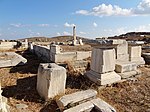Prytaneion
A prytaneion (
In general in ancient Greece, each state, city or village possessed its own central hearth and sacred fire, the prytaneion, representing the unity and vitality of the community. The fire was kept alight continuously, tended by the king or members of his family. The building in which this fire was kept was the prytaneion, and the chieftain (the king or prytanis) probably made it his residence. The building contained the holy fire of Hestia, the goddess of the hearth, and symbol of the life of the city.
The term prytanis (pl. prytaneis) is generally applied specially to those who, after the abolition of absolute monarchy, held the chief office in the state. Rulers of this name are found at Rhodos as late as the 1st century BC.
Function
The prytaneion was regarded as the religious and political center of the community and was thus the nucleus of all government, and the official "home" of the whole people. When members of the state went forth to found a new colony they took with them a brand from the prytaneion altar to kindle the new fire in the colony; the fatherless daughters of
Athens
The site of the prytaneion at Athens cannot be definitely fixed; it is generally supposed that in the course of time several buildings bore the name. The prytaneion, mentioned by
Polemon of Athens said that copies of the laws of Solon were kept in the prytaneion, engraved on square wooden tablets which revolved on pivots in such a way that when the tablets were turned at an angle they seemed to be triangular. Pausanias says briefly that the laws of Solon were inscribed in the prytaneion.[6]
There was also a court of justice called the court of the prytaneion; all that is known of this court is that it tried murderers who could not be found, and inanimate objects which had caused death.[7]
Achaea
In Achaea, this central hall was called the Lefton (town-hall), and a similar building is known to have existed at Elis.[citation needed]
Olympia
At
Naucratis
Gallery
See also
- Prytanée
References
This article incorporates text from a publication now in the public domain: Chisholm, Hugh, ed. (1911). "Prytaneum and Prytanis". Encyclopædia Britannica (11th ed.). Cambridge University Press.
- ^ 2.15
- ^ Plato (1860). Plato's Apology and Krito, with notes by W. S. Tyler. Apology. NY: D. Appleton & Co. p. 21.
- ^ Ch. 3
- . Retrieved 14 December 2021.
- ^ Matthaiou, Angelos; Kavvadias, George. "G, Kavvadias - A.P. Matthaiou, A new Attic inscription of the fifth cent. B.C. from the East Slope of the Acropolis". Academia.edu. Retrieved 14 December 2021.
- ^ Frazer, James (1917). Studies in Greek Scenery, Legend and History. London: Macmillan and Company, Ltd. pp. 140.
- ^ Demosthenes. "Dem. 23, 76". Against Aristocrates.
- ^ "Project Perseus:", Olympia, Prytaneion (Building)
- Calvin College
- ^ Calvin College
- ^ "Athénée de Naucratis : Deipnosophistes : livre IV : texte grectraduction". Remacle.org. Retrieved 14 December 2021.
Sources
- Miller, Stephen G. The Prytaneion. Its Function and Architectural Form. Berkeley: University of California Press, 1978.





